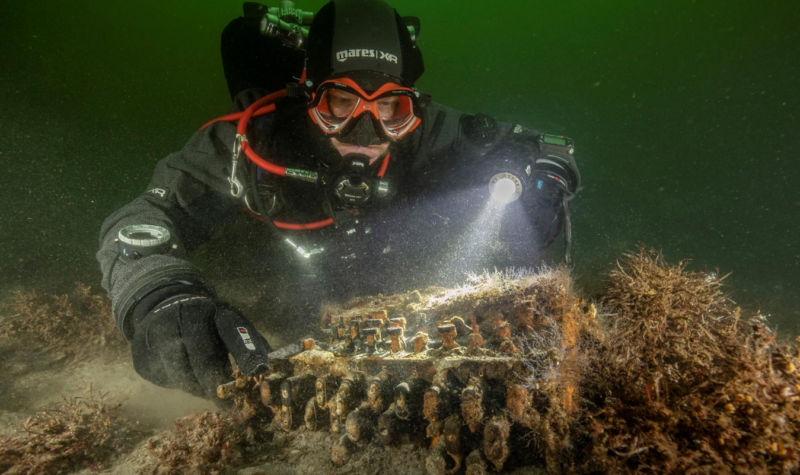
When Nazi naval officers tossed their ship’s Enigma encryption machine overboard, they probably thought they were putting the device beyond anyone’s reach. Blissfully unaware that Allied cryptanalysts in Poland and at Bletchley Park in the UK had broken the Enigma code, the Nazis had standing orders to destroy their encryption devices to keep them out of Allied hands. Eighty years later, divers found the once-secret device tangled in an abandoned fishing net on the seafloor, and now it’s set to be put on display for everyone to see. LOL, Nazis pwned.
Research diver Florian Huber and his colleagues were trying to clear abandoned fishing nets from the Bay of Gelting, on the Baltic Sea near the German-Danish border, when they found the artifact. Derelict nets and other discarded fishing gear can still entangle fish, sea turtles, diving birds, and marine mammals like seals and dolphins. The World Wildlife Fund had hired the divers to clear them in November 2020.
“A colleague swam up and said ‘There’s a net there with an old typewriter in it,” Huber told the DPA news agency.
That’s no typewriter
During World War II, the Nazi military used the Enigma device to encrypt important communications about military plans and movements. To encrypt a message, the sender typed a plain-text message, such as “We attack at dawn” onto the machine’s keyboard. The machine converts each typed letter into a new letter to scramble the message into something like “XN LUSJVD TW SFPQ.” When the receiver types the coded message on an Enigma device with the same settings, “XN LUSJVD TW SFPQ” once more becomes “We attack at dawn.”
You might notice that even though the letter “A” shows up four times in the original message, it’s encoded differently every time in the Enigma-encrypted version. That’s because the Enigma machine used a set of rotors to change the code for each letter every time the operator pressed a key. The absence of clues like repeating letters made it harder for cryptanalysts to crack the code. After all, something like “FPPFKL FP RFMQ” is a bit easier to parse into “Attack at dawn.”
The machine that divers recently fished out of the Bay of Gelting had three rotors, which means it probably came from a surface warship and not a Nazi submarine, or U-boat. From 1942 onward, U-boats carried a four-rotor model of the Enigma device. Several U-boat commanders scuttled their submarines in May 1945 as the Allies closed in. But the presence of a three-rotor machine suggests that at least one surface ship’s officers also threw their Enigma machine overboard in the final days of the war.
After 75 years at the bottom of the sea, the Enigma machine was in remarkably good condition. But conservators at the Schleswig Holstein state archaeology museum in Germany say it still needs about a year’s worth of cleaning and restoration before it’s ready for display.
Cracking the code
Settings that programmed the rotors to substitute new letters changed every 24 hours; each unit had a codebook of daily settings, issued in advance. To decrypt a message, the receiver’s machine needed to use the same settings as the sender. Otherwise, the code seemed nearly impossible to crack.
At Bletchley Park, a highly secretive facility hidden away in a British country estate, mathematician Alan Turing and his colleagues were able to read encrypted Enigma messages by 1941. Throughout the war, they kept pace with Nazi cryptographers’ constant upgrades to Enigma.
Less than a decade after the war, Turing took his own life shortly after a British court sentenced him to chemical castration for homosexuality, which was then illegal in the UK. His role at Bletchley Park wasn’t well known at the time; the Allies kept the decryption of Enigma a closely-guarded secret until the 1970s. Historians generally agree that breaking the Enigma code probably shortened the war by at least years, although that sort of thing is nearly impossible to quantify.
The Link LonkDecember 27, 2020 at 09:00PM
https://ift.tt/3nSATid
Divers recover a WWII Code Machine from the Baltic Sea - Ars Technica
https://ift.tt/2CoSmg4
Sea
/cloudfront-us-east-2.images.arcpublishing.com/reuters/CZF6NULMVVMEXHOP7JK5BSPQUM.jpg)
No comments:
Post a Comment